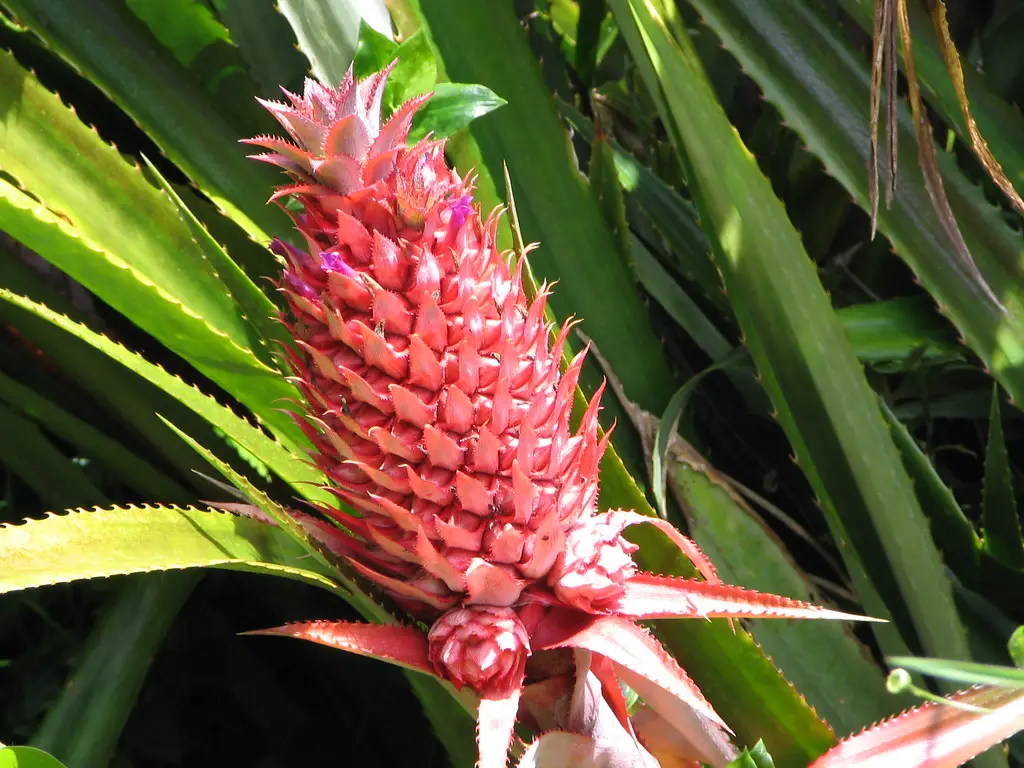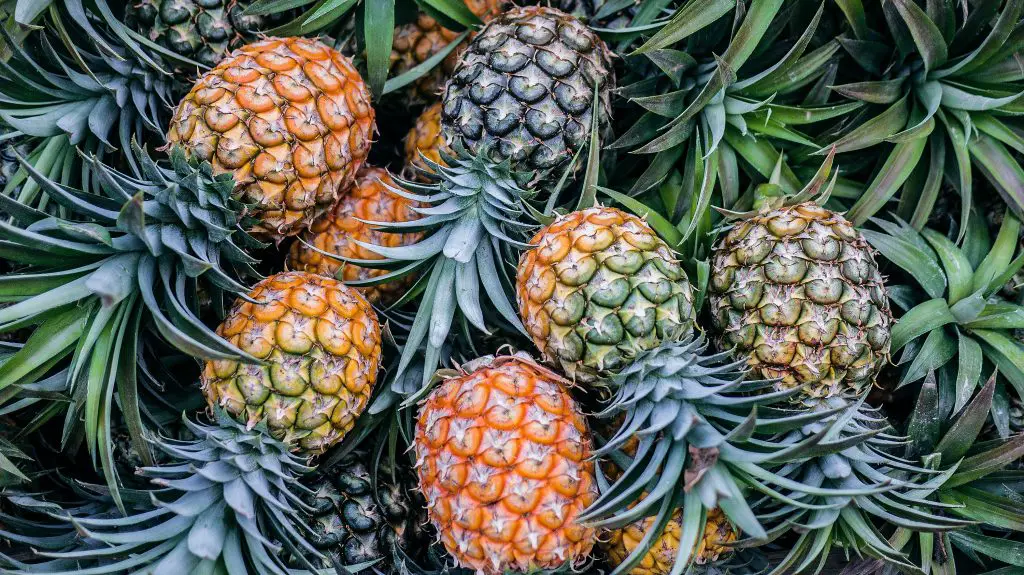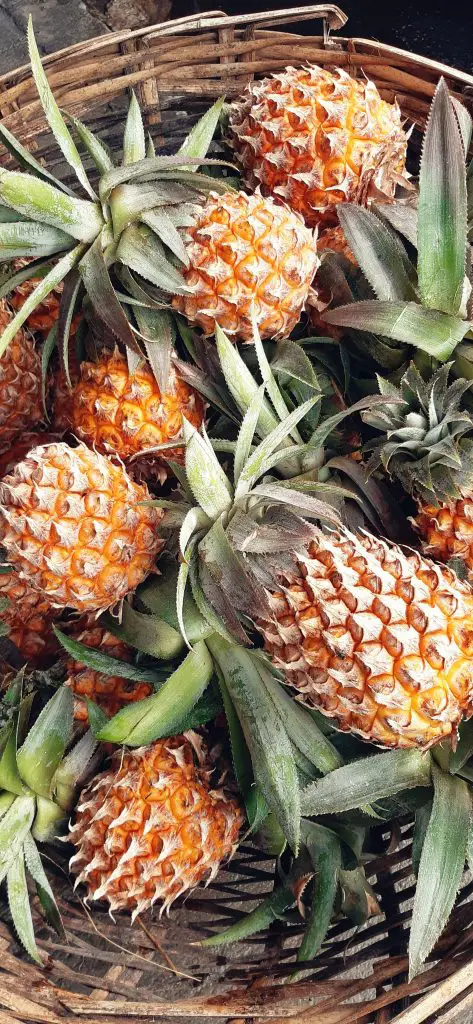Do Pineapples Grow On Trees? Pineapple is an extremely popular summer fruit that is eaten the world over either as fresh fruit or from a can. It is known to be grown primarily in the tropics for commercial reasons, however, it is also possible to grow them in cooler locations if you can maintain a warm growing environment. However, many people have wondered whether the pineapples grow on trees.
Pineapples do not grow on trees, they instead are grown on a small plant that is typically 2 to 3 ft tall and has leaves similar to a bromeliad or a clivia. The fruit itself is produced on a flowering spike that comes up from the centre of the plant to produce a single fruit. An example of a pineapple plant flowering is shown in the image below.

Given the small size of the plant, it is actually possible to grow pineapples indoors in cooler conditions using the fruit that you purchase from the supermarket. The trick of growing pineapples in a cooler climate was first perfected by victorian kitchen gardeners that grew them in greenhouses for their employers. There was a period in the 19th-century when it was very fashionable at dinner parties to have pineapple on the table for Christmas.
About Pineapples
As mentioned above pineapples are a tropical plant that is a member of the bromeliad family and originated in South America. It has been grown for thousands of years in South America, though the specific date of the domestication of the fruit is not known, but there is evidence that the fruit was cultivated at least 3000 years ago in Peru.
It is also known that by the late 1400s the pineapple was a dietary staple of the indigenous people of South America. As a result of this widespread use in South America, Christopher Columbus encountered the fruit in his visit in 1493. However, it was not introduced into Europe until the 17th century at which point it quickly became a symbol of wealth and power in places like the UK where the fruit was produced in heated glasshouses.
The plant itself is a frost-sensitive perennial herbaceous plant that grows between 2 and 3 ft tall and sometimes is slightly taller when it is in flower. The flower itself is red and has an unusual geometric shape.
The individual fruit that is produced from the flower join together to form the larger fruit which we know as a pineapple. The fruit itself can be used to propagate the plant by cutting off its top however commercial producers also use suckers that are produced at the base of the plant after it flowers as another way to propagate the plant.

How To Grow Pineapple From Supermarket Varieties
One of the most common ways to grow a pineapple is to simply purchase one from the local supermarket and propagate the plant from there. This can be easily done by removing the top of the pineapple approximately half an inch below the leaves.
Once the top is removed it is recommended that you allow it to dry out for approximately a week or so as this will allow the top to heal somewhat which would reduce the chances of there being problems with rotting.
When the top is ready it is recommended that you place it into a pot that contains a relatively light and aerated soil mixture. The top of the pineapple should be buried approximately an inch below the soil.
Place the pot into a location that is relatively warm and well lit but not exposed to direct sunlight. The reason that this is generally not recommended is because the plant can dry out quite quickly. At this point in time, it is important to keep the soil moist until the plant begins to develop roots which typically takes around 6 weeks to 2 months depending upon the temperature.
After this period the pineapple is less susceptible to moisture loss though it is still recommended that you water the soil regularly. As the plant develops it is important to ensure that you supply at least 6 hours of sunlight in a frost-free location.
In northern climates, the pineapples are relatively slow-growing so it is typical to see blooms after 2 to 3 years though some gardeners do have difficulty with this. One way that is recommended to encourage the flowering of the plants is to expose them to ethylene producing fruit such as apples, bananas, or pears for a few days.

This can be done by placing the fruit on the surface of the pot and then covering it over with a plastic bag to ensure that the ethylene is retained around the plant. Typically, if you follow this process you can expect that you’ll get flowers appearing two to three months after this process has been completed.
As mentioned above the flower that is produced is typically red in color and will progressively change color until it develops the characteristic yellow to orange outer skin. It is important not to remove the fruit until it is well and truly ripe. The reason for this is that the fruit will not sweeten properly if picked too early, even though the color of the skin will continue to change if picked early.
As mentioned in the article earlier on, the plant will produce suckers after it flowers which can be used to propagate the plant rather than using a top again which will limit the number of plants that you can produce.
However, it is important to note that the mother plant will slowly die after fruiting has occurred so once the suckers are taken from the plant it is best to dispose of it.
I hope you found this useful and have great success growing your own pineapple at home if you have any questions or comments please leave them in the section below.
Relevant Articles
Do Onions Grow Underground? What Is Normal?
Does Watermelon Grow Underground?
